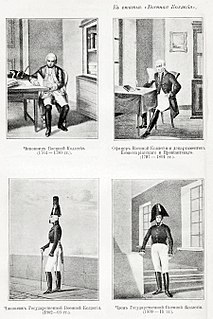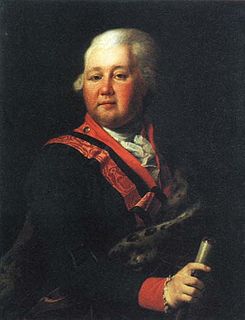
The government reforms of Peter I aimed to modernize the Tsardom of Russia based on Western and Central European models.
The Supreme Privy Council of Imperial Russia, founded on 19 February 1726 and operative until 1730, originated as a body of advisors to Empress Catherine I.

Prince Vasily Vladimirovich Dolgorukov was a Russian commander and politician, promoted to Field Marshal (генерал-фельдмаршал) in 1728. His life and fortune swung like a weather vane, due to complex plots and the troubled time following Peter the Great's death.
The Procurator was an office initially established in 1722 by Peter the Great, the first Emperor of the Russian Empire, as part of reforms to bring the Russian Orthodox Church more directly under his control.

The College of War was a Russian executive body, created in the government reform of 1717. It was the only one of the six original and three later colleges to survive the decentralising reforms of Catherine II of Russia. Under Paul I, it became the model for a newly centralised government.
The Collegium of Commerce was a Russian executive body (collegium), created in the government reform of 1717. It was de-established in 1796 or 1786 following the decentralising reforms of Catherine II of Russia. Its first President was Pyotr Tolstoy.
The Collegium of Justice was a Russian executive body (collegium), created in the government reform of 1717. It was de-established during the decentralising reforms of Catherine II of Russia. Its first President was Andrey Matveev.
The Collegium of Foreign Affairs was a Russian executive body (collegium), created in the government reform of 1717. In 1802, it was made subordinate to the Ministry of Foreign Affairs and was abolished in 1832. Its first President was Fyodor Golovin.
The Collegium of Accounting was a Russian executive body (collegium), created in the government reform of 1717. It was de-established during the decentralising reforms of Catherine II of Russia. Its first President was Vasily Dolgorukov.
The Collegium of Mining and Manufacturing was a Russian executive body (collegium), created in the government reform of 1717. Its first President was Ivan Musin-Pushkin.
The Collegium of Mining was an executive body in the Russian Empire from 1722, when the Collegium of Mining and Manufacturing split into two. It was closed in 1783 under Catherine II of Russia, before being reopened in 1796.

Accounts Chamber of the Russian Federation is the parliamentary body of financial control in the Russian Federation.
Collegium of Little Russia was an administrative body of the Russian Empire in the Hetmanate created for the first time by the ukase of Peter the Great on May 27, 1722 in place of the Little Russia Prikase.
Alexey Grigoryevich Dolgorukov was a Russian politician and member of the Supreme Privy Council under Peter II. He is cousin of Vasily Lukich Dolgorukov.
Stepan Lukich Velyaminov was a Russian military and state figure, Major General, President of Collegium of Little Russia (1722-27), privy councilor, senator.

Count Valentin Platonovich Musin-Pushkin was a Russian military and government official who reached the rank of field marshal.

The Council at the Highest Court was the highest advisory institution in the Russian Empire that existed since 1768 to 1801.










